简介
- 简介
- Cache的核心是LocalCache
- LocalCache 的核心是Segment
- Segment 的基本元素ReferenceEntry 和 ValueReference
- 弱引用
- segment.get
- 如果不想线程排队
Guava LocalCache 缓存介绍及实现源码深入剖析
guava LocalCache与ConcurrentHashMap有以下不同
- ConcurrentHashMap ”分段控制并发“是隐式的(实现中没有Segment对象),而LocalCache 是显式的。
- 在Cache中,使用ReferenceEntry来封装键值对,并且对于值来说,还额外实现了ValueReference引用对象来封装对应Value对象。
- 在Cache 中支持过期 + 自动loader机制,这也使得其加锁方式与ConcurrentHashMap 不同。
- 在Cache中,在segment 粒度上支持了LRU机制, 体现在Segment上就是 writeQueue 和 accessQueue。队列中的元素按照访问或者写时间排序,新的元素会被添加到队列尾部。如果,在队列中已经存在了该元素,则会先delete掉,然后再尾部add该节点
Cache的核心是LocalCache
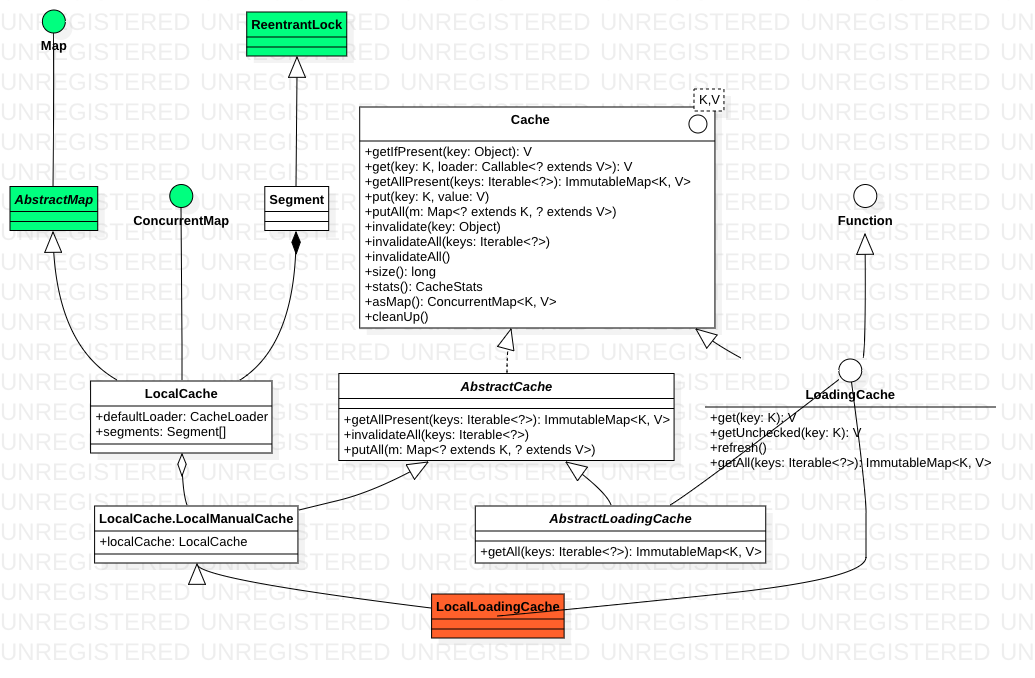
- 我们一般用的LoadingCache 实际实现类是 LocalLoadingCache,LocalLoadingCache 封装了LocalCache ==> 整个guava cache的核心是LocalCache。
- AbstractCache:This class provides a skeletal implementation of the Cache interface to minimize the effort required to implement this interface.To implement a cache, the programmer needs only to extend this class and provide an implementation for the get(Object) and getIfPresent methods. getAll are implemented in terms of get; getAllPresent is implemented in terms of getIfPresent; putAll is implemented in terms of put, invalidateAll(Iterable) is implemented in terms of invalidate. 这是一个典型抽象类的使用场景:skeletal implementation,封装通用逻辑,承接大部分interface 方法, 剩下几个个性化的方法留给子类实现。
LocalCache 的核心是Segment

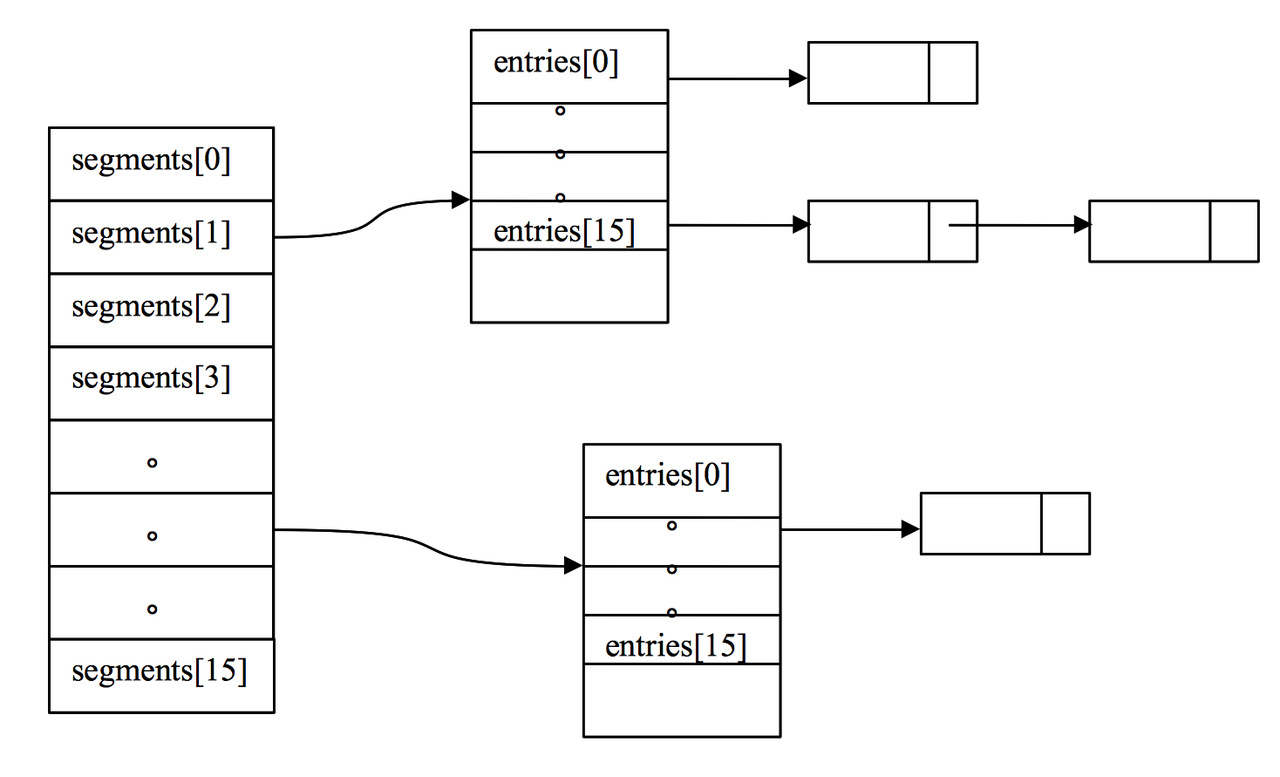
可以直观看到cache是以segment粒度来控制并发get和put等操作的
Segment 的基本元素ReferenceEntry 和 ValueReference
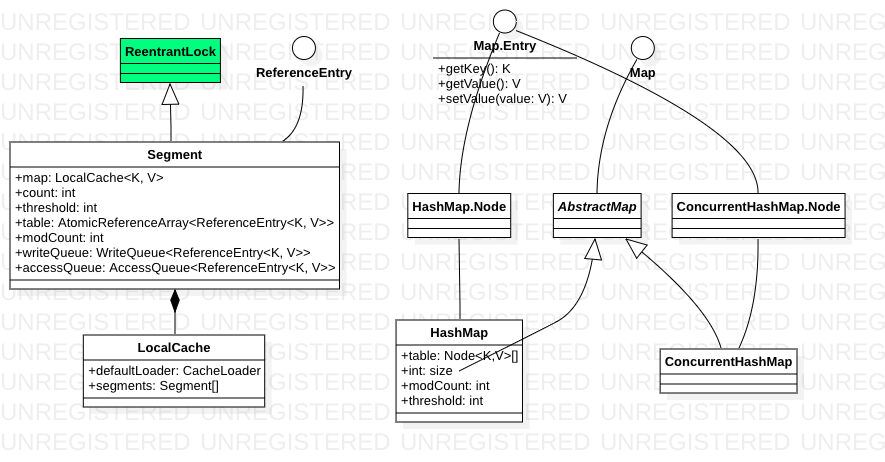
Map类结构简单说就是数组 + 链表,最基本的数据单元是entry
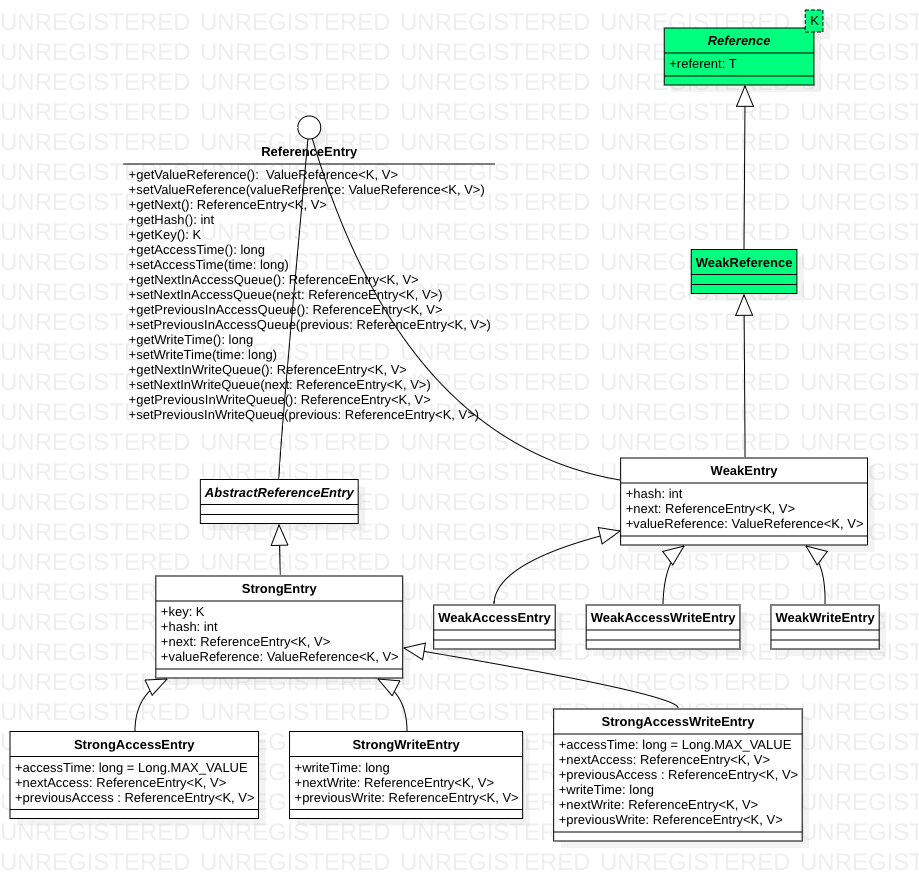
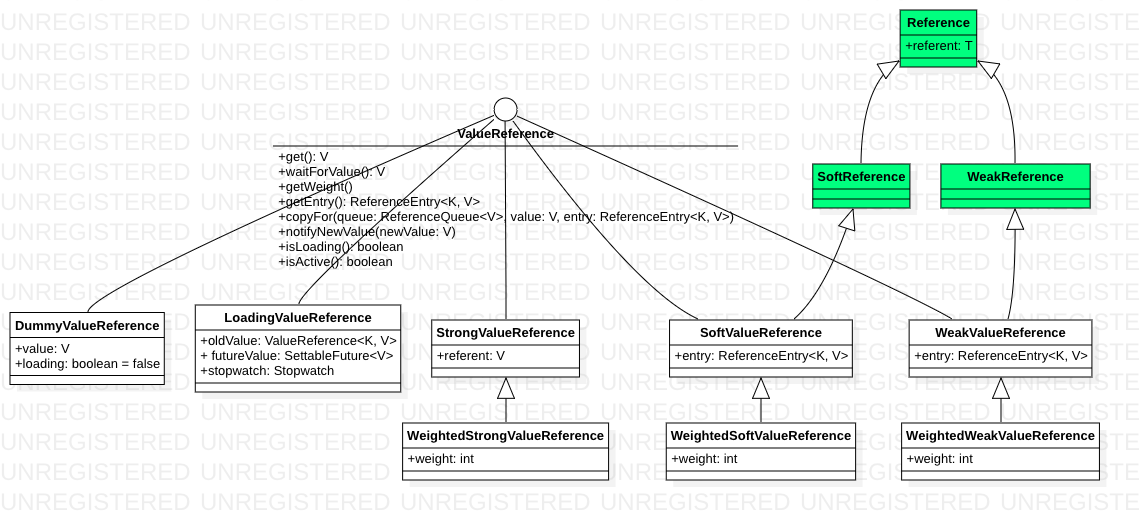
为了减少不必要的load加载,在value引用中(而不是常规的在key 上加锁)增加了loading标识和wait方法等待加载获取值。这样,调用方线程就可以等待上一个线程loader方法获取值,而不是重复去调用loader方法加重系统负担,而且可以更快的获取对应的值。
在Cache分别实现了基于Strong,Soft,Weak三种形式的ValueReference实现。
- 这里ValueReference之所以要有对ReferenceEntry的引用是因为在WeakReference、SoftReference被回收时,需要使用其key将对应的项从Segment段中移除;
- copyFor()函数的存在是因为在expand(rehash)重新创建节点时,对WeakReference、SoftReference需要重新创建实例(C++中的深度复制思想,就是为了保持对象状态不会相互影响),而对强引用来说,直接使用原来的值即可,这里很好的展示了对彼变化的封装思想;
- notifiyNewValue只用于LoadingValueReference,它的存在是为了对LoadingValueReference来说能更加及时的得到CacheLoader加载的值。
弱引用
| 回收时机 | |
|---|---|
| Strong Reference | 若一个对象通过一系列强引用可到达,它就是强可达的(strongly reachable),那么它就不被回收 |
| Soft Reference | 在内存不充足时才会被回收 |
| Weak Reference | gc时 |
| Phantom Reference/虚引用 | 通过虚引用甚至无法获取到被引用的对象 |
垃圾收集器会把那些刚清除的弱引用放入创建弱引用对象时所指定的引用队列(Reference Queue)中
Product productA = new Product(...);
WeakReference<Product> weakProductA = new WeakReference<>(productA);
当productA变为null时(表明它所引用的Product已经无需存在于内存中),这时指向这个Product对象的就只剩弱引用对象weakProductA了,这时候相应的Product对象是弱可达的
segment.get

主要逻辑就两个:lockedGetOrLoad 和 waitForLoadingValue
lockedGetOrLoad
下列代码只保留了load部分
V lockedGetOrLoad(K key, int hash, CacheLoader<? super K, V> loader) throws ExecutionException {
ReferenceEntry<K, V> e;
ValueReference<K, V> valueReference = null;
LoadingValueReference<K, V> loadingValueReference = null;
boolean createNewEntry = true;
lock(); // 加锁
int newCount = this.count - 1;
AtomicReferenceArray<ReferenceEntry<K, V>> table = this.table;
// 计算key在数组中的落点
int index = hash & (table.length() - 1);
ReferenceEntry<K, V> first = table.get(index);
// 沿着某个index 链表依次遍历
for (e = first; e != null; e = e.getNext()) {
K entryKey = e.getKey();
if (e.getHash() == hash
&& entryKey != null
&& map.keyEquivalence.equivalent(key, entryKey)) {
valueReference = e.getValueReference();
V value = valueReference.get();
if (value == null || map.isExpired(e, now){
enqueueNotification(...);
} else {
return value;
}
this.count = newCount; // write-volatile
break;
}
}
loadingValueReference = new LoadingValueReference<>();
if (e == null) {
e = newEntry(key, hash, first);
e.setValueReference(loadingValueReference);table.set(index, e);
} else {
e.setValueReference(loadingValueReference);
}
unlock(); // 解锁
synchronized (e) {
return loadSync(key, hash,loadingValueReference, loader);
}
}
segment 简单说也是数组加链表,只是元素类型是ReferenceEntry,根据key 计算index,然后沿着链表匹配value,若相同,判断value元素是否有效,无效(null or 过期)则创建loadingValueReference 并更新到 ReferenceEntry。loadingValueReference.loadFuture 开始执行load逻辑。
只有ReferenceEntry 更新 其value引用 loadingValueReference 的部分是需要加锁的,之后线程竞争便转移到了 loadingValueReference 上
V loadSync(K key,int hash,
LoadingValueReference<K, V>,loadingValueReference,CacheLoader<? super K, V> loader)throws ExecutionException {
ListenableFuture<V> loadingFuture = loadingValueReference.loadFuture(key, loader);
return getAndRecordStats(key, hash,loadingValueReference, loadingFuture);
}
请求合并的实现——waitForLoadingValue
V waitForLoadingValue(ReferenceEntry<K, V> e, K key, ValueReference<K, V> valueReference)
throws ExecutionException {
checkState(!Thread.holdsLock(e), "Recursive load of: %s", key);
V value = valueReference.waitForValue();
if (value == null) {
throw new InvalidCacheLoadException("CacheLoader returned null for key " + key + ".");
}
...
return value;
}
static class LoadingValueReference<K, V> implements ValueReference<K, V> {
volatile ValueReference<K, V> oldValue;
final SettableFuture<V> futureValue =SettableFuture.create();
final Stopwatch stopwatch =Stopwatch.createUnstarted();
public boolean set(@Nullable V newValue) {
return futureValue.set(newValue);
}
public V get() {
return oldValue.get();
}
public V waitForValue() throws ExecutionException {
// 对future.get的封装
return getUninterruptibly(futureValue);
}
public boolean setException(Throwable t) {
return futureValue.setException(t);
}
public void notifyNewValue(@Nullable V newValue) {
if (newValue != null) {
// future.get ==> waitForValue即可立即返回
set(newValue);
} else {
oldValue = unset();
}
}
}
所谓请求合并:当多个线程请求同一个key时,第一个线程执行loader逻辑,其余线程等待。
从上述代码可以看到
- “其它线程等待”的效果,不是对key 加锁, 其它线程得不到锁而等待
-
LoadingValueReference 持有了 future对象,也是线程的“竞争点”,线程发现value 处于loading状态时 便直接
LoadingValueReference.waitForValue==>future.get准备等结果了。这个竞争点选的很精巧- 以 key 或者value 作为竞争点 + lock/unlock,线程发现key 数据过期,锁住key(标识key等手段),获取数据,解锁key。因为你不知道key/value 什么时候过期,所以每次lock/unlock 是很大的浪费。
- 以 value isLoading 作为竞争点,线程发现value isNotLoading,创建一个新的value 对象设置状态为loading,原子的修改entry的value,这样其它线程可以根据loading 状态决定自己的行为,而不是无脑lock/unlock
如果不想线程排队
Guava Cache内存缓存使用实践-定时异步刷新及简单抽象封装
只有一个用户线程排队
refreshAfterWrite 注意不是 expireAfterWrite
如果缓存过期,恰好有多个线程读取同一个key的值,那么guava只允许一个线程去加载数据,其余线程阻塞。这虽然可以防止大量请求穿透缓存,但是效率低下。使用refreshAfterWrite可以做到:只阻塞加载数据的线程,其余线程返回旧数据。
LoadingCache<String, Object> caches = CacheBuilder.newBuilder()
.maximumSize(100)
.refreshAfterWrite(10, TimeUnit.MINUTES)
.build(new CacheLoader<String, Object>() {
@Override
public Object load(String key) throws Exception {
return generateValueByKey(key);
}
});
另起线程拉新值
真正加载数据的那个线程一定会阻塞,可以让这个加载过程是异步的,这样就可以让所有线程立马返回旧值
ListeningExecutorService backgroundRefreshPools = MoreExecutors.listeningDecorator(Executors.newFixedThreadPool(20)); LoadingCache<String, Object> caches = CacheBuilder.newBuilder()
.maximumSize(100)
.refreshAfterWrite(10, TimeUnit.MINUTES)
.build(new CacheLoader<String, Object>() {
@Override
public Object load(String key) throws Exception {
return generateValueByKey(key);
}
@Override
public ListenableFuture<Object> reload(String key, Object oldValue) throws Exception {
return backgroundRefreshPools.submit(new Callable<Object>() {
@Override
public Object call() throws Exception {
return generateValueByKey(key);
}
});
}
});
